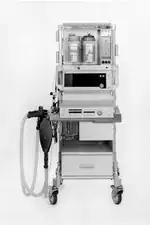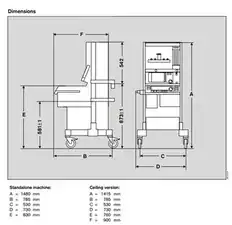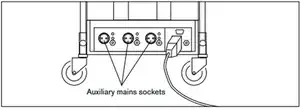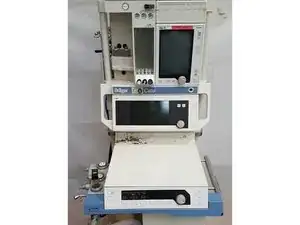Background and Identification

The Drager Cato ventilator is a universally applicable anesthetic workstation manufactured by a German-based company called “Drager.” Drager Cato is a conventional anesthetic machine, featuring low gas flow compensation and highly gas tight breathing system which meet the need for closed system anesthesia with simple carrier gas composition.
Main features of Cato edition:
- Inhalation anesthesia in semi-closed systems
- Inhalation anesthesia in virtually closed systems with low flow and minimal flow techniques for minimum gas and anesthetic consumption
- Inhalation anesthesia in non-rebreathing systems with separate fresh gas outlet for connecting e.g. Kuhn system.
- Automatic ventilation (IPPV)
- Synchronized intermittent mandatory ventilation (SIMV)
- Manual ventilation (MAN)
- Spontaneous breathing (SPONT)
Measurement and Monitoring functions:
- Measurement of ventilation parameters (pressure, flow, O2 concentration inspiratory and expiratory).
- Continuous measurement of CO2 concentration and N2O/anesthetic concentration (halothane, enflurane, isoflurane, sevoflurane, desflurane). The flow rate for sampling the measuring gas can be varied and is returned to the circulation.
- Automatic adjustment of the alarm limits for automatic ventilation (IPPV).
- Anesthetic vaporizer with automatic vapor recognition.
- Continuous non-invasive measurement of functional O2 saturation (optional)
- Measurement of inspiratory breathing gas temperature (optional)
The following values are indicated on these ventilators – continuous curve of airway pressure, peak, mean pressure, PEEP, and plateau pressure, patient compliance, expiratory minute volume, tidal volume and respiration rate, expiratory flow curve, inspiratory and expiratory O2 concentration of N2O and anesthetic halothane, enflurane, isoflurane, sevoflurane and desflurane, continuous CO2 curve and list entries and trend displays.
Monitored Parameters include airway pressure, expiratory minute volume, inspiratory O2 concentration, inspiratory and expiratory CO2 concentration, inspiratory anesthetic concentration. Some optional monitored parameters (depending on the model number) are functional O2 saturation and pulse and inspiratory breathing gas temperature with invariable upper alarm limit.
Intended Audience
This device is operated by respiratory therapists, and other medical workers, who are responsible for maintaining this medical equipment.
News references:
- A design fault of the Drager Cato anaesthesia workstation
- Temperature and humidity of the Drager Cato anesthetic machine circuit
For detailed instructions on “how to use Drager Cato”, please view official documentation.
Physical Characteristics
Identification: The Serial No. and Article no. are located on the rating plate (nameplate) on the back of the machine. The Article No. also specifies the equipment level of the machine.
Weight: Cato basic machine approx. 140 kg and Cato with two Vapors and monitor approx. 180 kg
Dimensions: See the image below

Technical Specifications
Power Supply
Rated operating voltages: depending on power adapter (100 VAC +10 %, –15 %, 50/60 Hz; power adapter 120 VAC ±10 %, 50/60 Hz; 127 VAC ±10 %, 50/60 Hz; 230 VAC ±10 %, 50/60 Hz; 240 VAC ±10 %, 50/60 Hz)
Conversion only by specially trained personnel.
Power input: Max. 280 W (without auxiliary power sockets and without accessories)
Fuses: The fuses in the power adapter and master switch on contactor are only accessible to qualified personnel with special tools. Auxiliary power sockets (3x): 2 fuses installed per socket (2A DIN 41 622, 230/240 VAC)
Auxiliary mains sockets: Do not connect any HF surgery devices to the auxiliary mains sockets! The connection of devices to the auxiliary mains socket may result in increased risk of electric shock in the event of earthing failure!

Medical Gas Supply
Pneumatic connections: Piped medical gas supply – O2, N2O, AIR Spare gas cylinders 11 L or 3 L for O2 and N2O (optional) Anaesthetic gas scavenging
Required pressures (piped supply): O2: 2.7 to 5.5 bar, N2O: 2.7 to 5.5 bar, AIR: 2.7 to 5.5 bar
Maximum gas consumption: O2: 100 L/min at 5 bar ± 10%, including 50 L/min at 5 bar ± 10 % for O2 flush; N2O: 20 L/min at 5 bar ± 10%; AIR: 50 L/min at 5 bar ± 10%
O2 shortage signal: Whistling signal tone. Triggered: at latest when O2 pressure drops below 170 kPa (1.7 bar) Stops: at latest when O2 pressure rises above 260 kPa (2.6 bar)
More technical details including Breathing system, Ventilator, Gas Delivery, Monitor specs, gas measurements, and Data Communication can be found here.
Sources: Instruction Document
Additional Information
- Drager Cato Service Manual: This manual provides troubleshooting steps and technical designs of the equipment.
- MedWrench: This site provides an open source forum related to this device.
- Drager Cato Official Document: This official document is provided by the manufacturer which provides detailed instructions on “how to use this device”.
